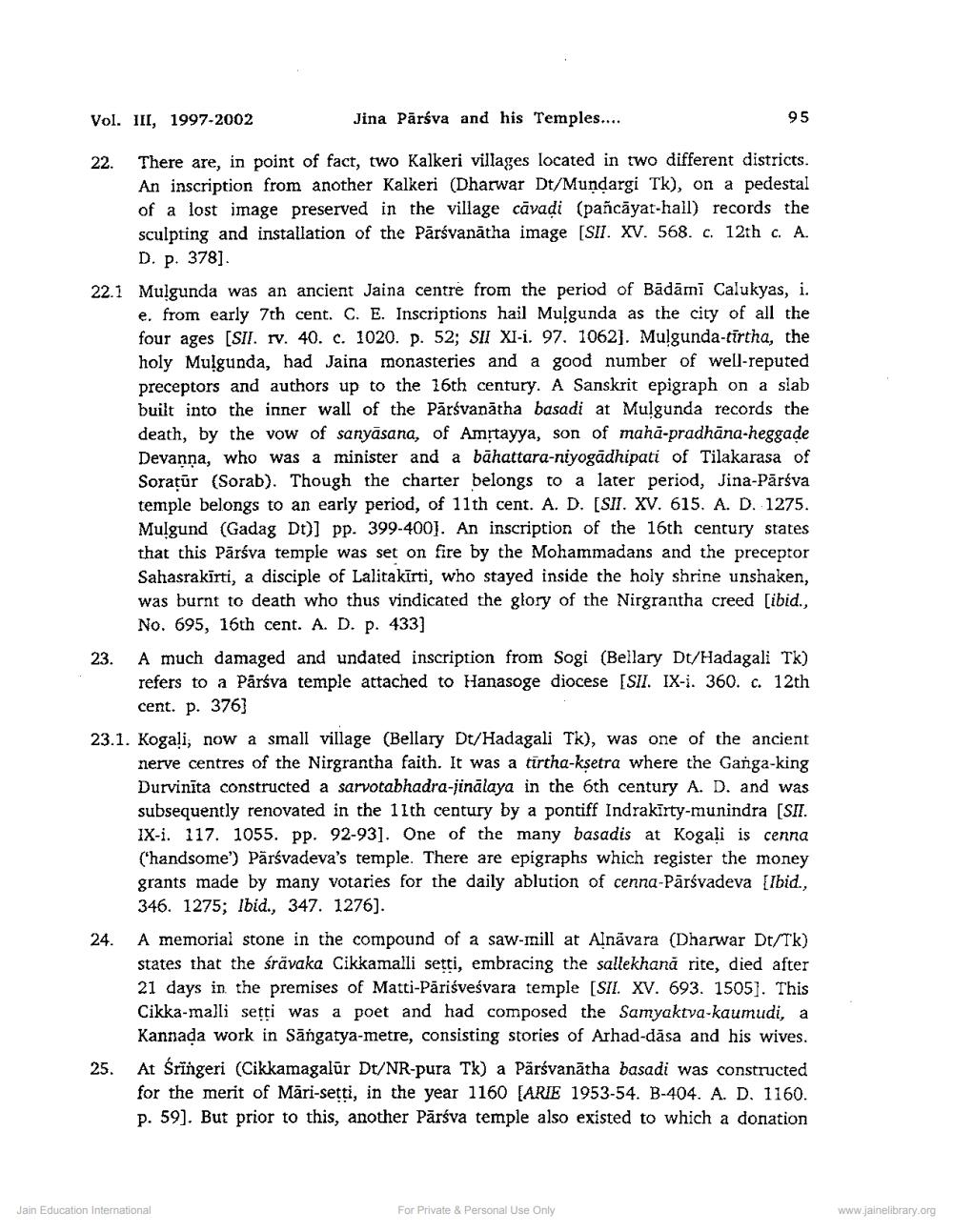________________
Vol. III, 1997-2002
Jina Parsva and his Temples....
There are, in point of fact, two Kalkeri villages located in two different districts. An inscription from another Kalkeri (Dharwar Dt/Mundargi Tk), on a pedestal of a lost image preserved in the village cavadi (pañcâyat-hall) records the sculpting and installation of the Parsvanatha image [SII. XV. 568. c. 12th c. A. D. p. 378].
22.
22.1 Mulgunda was an ancient Jaina centre from the period of Bādāmī Calukyas, i. e. from early 7th cent. C. E. Inscriptions hail Mulgunda as the city of all the four ages [SII. rv. 40. c. 1020. p. 52; SII XI-i. 97. 1062]. Mulgunda-tirtha, the holy Mulgunda, had Jaina monasteries and a good number of well-reputed preceptors and authors up to the 16th century. A Sanskrit epigraph on a slab built into the inner wall of the Parsvanatha basadi at Mulgunda records the death, by the vow of sanyasana, of Amṛtayya, son of maha-pradhana-heggade Devanna, who was a minister and a bahattara-niyogadhipati of Tilakarasa of Soratur (Sorab). Though the charter belongs to a later period, Jina-Pārsva temple belongs to an early period, of 11th cent. A. D. [SII. XV. 615. A. D. 1275. Mulgund (Gadag Dt)] pp. 399-400]. An inscription of the 16th century states that this Pārsva temple was set on fire by the Mohammadans and the preceptor Sahasrakirti, a disciple of Lalitakirti, who stayed inside the holy shrine unshaken, was burnt to death who thus vindicated the glory of the Nirgrantha creed [ibid., No. 695, 16th cent. A. D. p. 433]
23.
24.
95
23.1. Kogali, now a small village (Bellary Dt/Hadagali Tk), was one of the ancient nerve centres of the Nirgrantha faith. It was a tirtha-kṣetra where the Ganga-king Durvinita constructed a sarvotabhadra-jinālaya in the 6th century A. D. and was subsequently renovated in the 11th century by a pontiff Indrakirty-munindra [SII. IX-i. 117. 1055. pp. 92-93]. One of the many basadis at Kogali is cenna (handsome") Pärivadeva's temple. There are epigraphs which register the money grants made by many votaries for the daily ablution of cenna-Parsvadeva [Ibid., 346. 1275; Ibid., 347. 1276).
25.
A much damaged and undated inscription from Sogi (Bellary Dt/Hadagali Tk) refers to a Parsva temple attached to Hanasoge diocese [SII. IX-i. 360. c. 12th cent. p. 376]
A memorial stone in the compound of a saw-mill at Alnavara (Dharwar Dt/Tk) states that the śrävaka Cikkamalli setti, embracing the sallekhană rite, died after 21 days in the premises of Matti-Pāriśveśvara temple [SII. XV. 693. 1505]. This Cikka-malli setti was a poet and had composed the Samyaktva-kaumudi, a Kannada work in Sangatya-metre, consisting stories of Arhad-dāsa and his wives. At Sringeri (Cikkamagalur Dt/NR-pura Tk) a Pārsvanatha basadi was constructed. for the merit of Mari-setti, in the year 1160 [ARIE 1953-54. B-404. A. D. 1160. p. 59]. But prior to this, another Parsva temple also existed to which a donation
Jain Education International
For Private & Personal Use Only
www.jainelibrary.org




